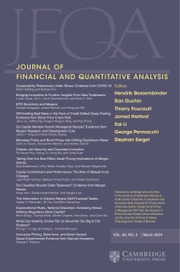No CrossRef data available.
Article contents
Tail Risk Around FOMC Announcements
Published online by Cambridge University Press: 11 August 2025
Abstract
Predictive regressions of market returns on option-implied moments measured before pre-scheduled FOMC meetings show that tail risks play an important role in understanding the market risk premium around FOMC announcement days. Skewness and kurtosis, which capture investors’ expectations of the tails of the return distribution, robustly predict post-FOMC returns both in-sample and out-of-sample. The predictability lasts up to 1 week and is stronger for expansionary monetary policy shocks. The signs of the corresponding risk premiums are consistent with economic intuition, illustrating the role of periods with high risk premiums to confirm theoretical predictions.
Information
- Type
- Research Article
- Information
- Creative Commons
- This is an Open Access article, distributed under the terms of the Creative Commons Attribution licence (http://creativecommons.org/licenses/by/4.0), which permits unrestricted re-use, distribution and reproduction, provided the original article is properly cited.
- Copyright
- © The Author(s), 2025. Published by Cambridge University Press on behalf of the Michael G. Foster School of Business, University of Washington
Footnotes
We are grateful to George Pennacchi (the editor) and an anonymous referee. We thank Hengjie Ai, Ehsan Azarmsa, Gurdip Bakshi, Aaron Burt, Hitesh Doshi, Lerby Ergun (discussant), Chitru Fernando, Thomas George, Travis Johnson, Praveen Kumar, Alexander Kurov (discussant), Charles Martineau (discussant), Dmitriy Muravyev (discussant), Oleg Rytchkov, Rafal Sieradzki (discussant), Robert Van Ness, Christian Wagner (discussant), Tong Wang, Michael Weber, Lai Xu, Pradeep Yadav, Yucheng Yang (discussant), and seminar participants at Colorado State University, University of Houston, University of Mississippi, University of Oklahoma, and participants at the European Finance Association 2024 Annual Conference, Canadian Derivatives Institute 2023 Annual Conference, Chinese Economists Society 2023 North America Conference, Financial Management Association 2023 Annual Meeting, Midwest Finance Association 2024 Annual Meeting, Northern Finance Association 2023 Annual Meeting, and Southern Finance Association 2023 Annual Meeting for helpful comments. We thank Ping Zhang for excellent research assistance.

